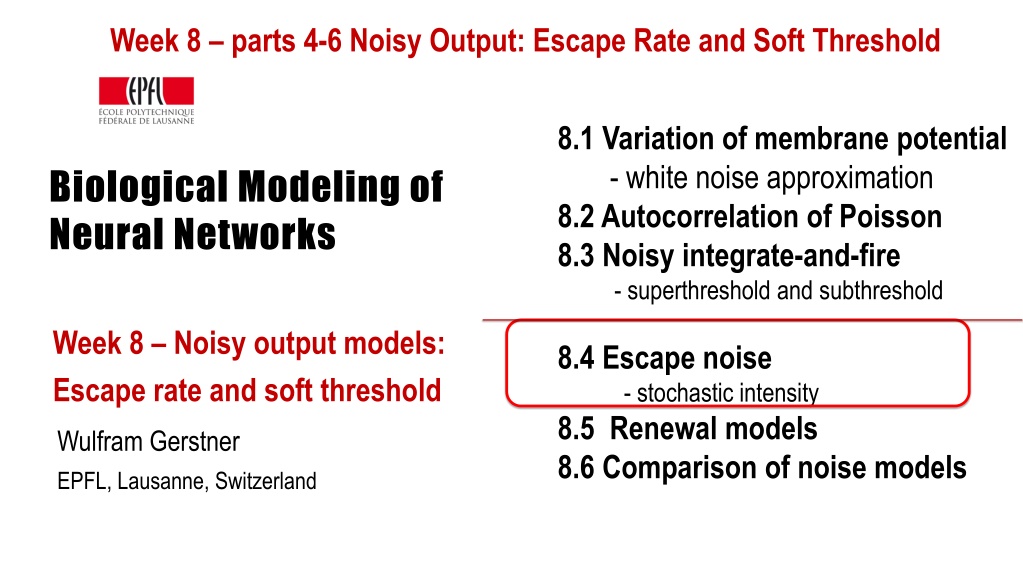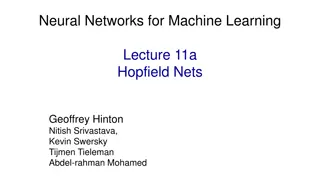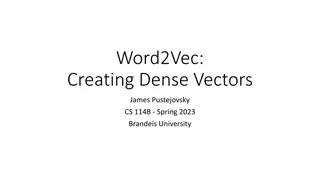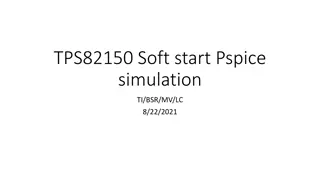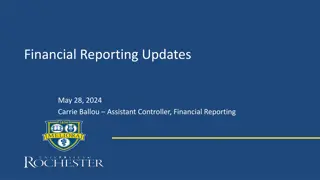Exploring Noisy Output in Neural Networks: From Escape Rate to Soft Threshold
Delve into the intricacies of noisy output in neural networks through topics such as the variation of membrane potential with white noise approximation, autocorrelation of Poisson processes, and the effects of noise on integrate-and-fire systems, both superthreshold and subthreshold. This exploration sheds light on biological modeling of neural networks.
Download Presentation

Please find below an Image/Link to download the presentation.
The content on the website is provided AS IS for your information and personal use only. It may not be sold, licensed, or shared on other websites without obtaining consent from the author. Download presentation by click this link. If you encounter any issues during the download, it is possible that the publisher has removed the file from their server.
E N D
Presentation Transcript
Week 8 parts 4-6 Noisy Output: Escape Rate and Soft Threshold 8.1Variation of membrane potential - white noise approximation 8.2 Autocorrelation of Poisson 8.3 Noisy integrate-and-fire - superthreshold and subthreshold Biological Modeling of Neural Networks Week 8 Noisy output models: Escape rate and soft threshold 8.4 Escape noise - stochastic intensity 8.5 Renewal models 8.6 Comparison of noise models Wulfram Gerstner EPFL, Lausanne, Switzerland
Neuronal Dynamics Review:Sources of Variability - Intrinsic noise (ion channels) -Finite number of channels -Finite temperature Na+ K+ -Network noise (background activity) -Spike arrival from other neurons -Beyond control of experimentalist Noise models?
Noise models escape process, stochastic intensity stochastic spike arrival (diffusive noise) (t ) u(t) t t t noisy integration escape rate du = ( ) ( ( ) ) t f u t = + + (t ) u RI i i dt Now: Escape noise! Relation between the two models: later
Neuronal Dynamics 8.4Escape noise escape process 1 ( ) u t escape rate = ( ) t exp( ) (t ) u(t) t t escape rate = ( ) ( ( ) ) t f u t Example: leaky integrate-and-fire model du dt = u u + ( ) ( ) RI t rest ( ) + = f f if spike att u t u r u
Neuronal Dynamics 8.4stochastic intensity escape process Escape rate = stochastic intensity of point process (t ) u(t) = ( ) t ( ( )) f u t t t escape rate = ( ) ( ( ) ) t f u t 1 ( ) u t examples = ( ) t exp( ) = ( ) t u
Neuronal Dynamics 8.4mean waiting time du dt escape rate = u u + ( ) ( ) RI t rest = ( ) ( ( ) ) t f u t u(t) (t ) 1ms t u 1ms I(t) mean waiting time, after switch t
Neuronal Dynamics 8.4escape noise/stochastic intensity Escape rate = stochastic intensity of point process = ( ) t ( ( )) f u t (t ) u(t) t t
Neuronal Dynamics Quiz 8.4 Escape rate/stochastic intensity in neuron models [ ] The escape rate of a neuron model has units one over time [ ] The stochastic intensity of a point process has units one over time [ ] For large voltages, the escape rate of a neuron model always saturates at some finite value [ ] After a step in the membrane potential, the mean waiting time until a spike is fired is proportional to the escape rate [ ] After a step in the membrane potential, the mean waiting time until a spike is fired is equal to the inverse of the escape rate [ ] The stochastic intensity of a leaky integrate-and-fire model with reset only depends on the external input current but not on the time of the last reset [ ] The stochastic intensity of a leaky integrate-and-fire model with reset depends on the external input current AND on the time of the last reset
Week 8 part 5 : Renewal model 8.1Variation of membrane potential - white noise approximation 8.2 Autocorrelation of Poisson 8.3 Noisy integrate-and-fire - superthreshold and subthreshold 8.4 Escape noise - stochastic intensity 8.5 Renewal models Biological Modeling of Neural Networks Week 8 Variability and Noise: Autocorrelation Wulfram Gerstner EPFL, Lausanne, Switzerland
Neuronal Dynamics 8.5. InterspikeIntervals t deterministic part of input ( ) I t u t noisy part of input/intrinsic noise escape rate ( ) Example: nonlinear integrate-and-fire model Example: exponential stochastic intensity du dt = + ( ) ( ) ) F u RI t = = ( ) t ( ( )) f u t exp( ( ) ) u t ( + = f f if spike att u t u r
Neuronal Dynamics 8.5. InterspikeInterval distribution escape process escape rate = ( ) ( ( ) ) t f u t (t ) u(t) Survivor function t t ) ) = d ( t t ( ) ( t t S t S I I dt t t
Neuronal Dynamics 8.5. InterspikeIntervals escape process Survivor function Examples now A (t ) ) ) = d ( t t ( ) ( t t S t S u(t) I I dt t t t t ) = ( t t SI exp( ( ) ' ) ' t dt escape rate ^ = ( ) ( ( ) ) t f u t Interval distribution t t ) = ) ' ( ( t t PI ( ) exp( ) ' t t dt ^ escape rate Survivor function u
Neuronal Dynamics 8.5. Renewal theory Example: I&F with reset, constant input escape rate (t ) ) ) = = ( t t ( ( t t )) exp( ( t t ) f u u t Survivor function ( S t t 1 t ) ) ' t t = t ( t t exp( ( ) ' S dt ) 0 t t Interval distribution ( P t t ) ) ) t = ( t t ( t t exp( ( ' ) ' P t dt t ) 0 ) = d ( t t S t dt
Neuronal Dynamics 8.5. Time-dependent Renewal theory Example: I&F with reset, time-dependent input, escape rate (t ) ) ) = = ( t t ( ( t t )) exp( ( t t ) f u u t Survivor function ( S t t t 1 t ) ) ' t t = ( t t exp( ( ) ' S dt ) t t Interval distribution ( P t t t ) ) ) t = ( t t ( t t exp( ( ' ) ' P t dt ) ) = d ( t t S t dt
Neuronal Dynamics Homework assignement neuron with relative refractoriness, constant input u = ( ) t escape rate for u 0 t t + Survivor function ) ( 0 t t S 1 = ( ) S t t 0 t Interval distribution ( 0 t t P 0 ) P t t = ( ) 0 t
Neuronal Dynamics 8.5. Firing probability in discrete time T 0 1t 3t 2t Probability to survive 1 time step t + 1 k = ( ) ] 1 k t = F ( | ) k t exp[ S t P = ( ') t dt ( ) exp[ '] S t t + 1 k k + 1 k k t k Probability to fire in 1 time step F kP =
Neuronal Dynamics 8.5. Escape noise -experiments Jolivet et al. , J. Comput. Neurosc. 2006 1 exp[ = ( ) ] k t F P k 1 ( ) u t = ( ) t exp( ) escape rate
Neuronal Dynamics 8.5. Renewal process, firing probability Escape noise = stochastic intensity -Renewal theory - hazard function - survivor function - interval distribution -time-dependent renewal theory -discrete-time firing probability -Link to experiments basis for modern methods of neuron model fitting
Week 8 part 6 : Comparison of noise models 8.1Variation of membrane potential - white noise approximation 8.2 Autocorrelation of Poisson 8.3 Noisy integrate-and-fire - superthreshold and subthreshold Biological Modeling of Neural Networks Week 8 Noisy input models: Barrage of spike arrivals 8.4 Escape noise - stochastic intensity 8.5 Renewal models 8.6 Comparison of noise models Wulfram Gerstner EPFL, Lausanne, Switzerland
Neuronal Dynamics 8.6.Comparison of Noise Models escape process (fast noise) stochastic spike arrival (diffusive noise) (t ) u(t) t ^t escape rate ^t noisy integration du = ( ) ( ( ) ) t f u t = + + (t ) u RI i i dt
Poisson spike arrival: Mean and autocorrelation of filtered signal ( ) F s = ( ) x t ( ) ( F s S t ) s ds = f ( ) ( ) S t t t f Filter = Assumption: stochastic spiking rate Autocorrelation of output ( ) x t ( ) ( ) F s S t s ds = ( ) x t ( ) ( ) F s t s ds mean ( ) t = ( ) ( ') x t x t ( ) ( F s S t ) ( ') ( ' F s S t ') ' s ds s ds = ( ) ( ') x t x t ( ) ( ') F s F s ( ) ( ' s S t ') ' S t s dsds Autocorrelation of input
Diffusive noise (stochastic spike arrival) Stochastic spike arrival: excitation, total rate Re inhibition, total rate Ri Synaptic current pulses q q d k k ' f f e i = + ( ) ( ) ( ) u u u t t t t rest ' k k dt C C , , ' ' f f EPSC IPSC d = + + Blackboard ( ) ( ) ( ) u u u R I t t rest dt u Langevin equation, Ornstein Uhlenbeck process 0u
Diffusive noise (stochastic spike arrival) d = + + ( ) ( ) ( ) u u u R I t t (t ) u rest dt (t ) u 2 = = ( ) ( ) ( ) ( ) ( ) u t u t u t u t u t Math argument: - no threshold - trajectory starts at known value ( ') u t = = ( ) ( ) ( ') u t u t ( ) ( ') u t u t u t
Diffusive noise (stochastic spike arrival) d = + + ( ) ( ) ( ) u u u R I t t rest (t ) u dt = ( ) ( ) u t u t 0 2 = = ( ) ( ) ( ) ( ) ( ) u t u t u t u t u t ( ') u t = = ( ) ( ) ( ') u t u t ( ) ( ') u t u t u t Math argument ( )] u t = [1 exp( 2 / )] 2 2 u [ t
Neuronal Dynamics 8.6.Diffusive noise/stoch. arrival A) No threshold, stationary input Membrane potential density: Gaussian u u constant input rates no threshold p(u) noisy integration du = + + (t ) u RI i i dt
Neuronal Dynamics 8.6Diffusive noise/stoch. arrival B) No threshold, oscillatory input Membrane potential density: Gaussian at time t u u p(u(t)) noisy integration du = + + (t ) u RI i i dt
Neuronal Dynamics 6.4.Diffusive noise/stoch. arrival C) With threshold, reset/ stationary input Membrane potential density u u p(u)
Neuronal Dynamics 8.6.Diffusive noise/stoch. arrival Superthreshold vs. Subthreshold regime u p(u) p(u) Nearly Gaussian subthreshold distr. Image: Gerstner et al. (2013) Cambridge Univ. Press; See: Konig et al. (1996)
Neuronal Dynamics 8.6.Comparison of Noise Models escape process (fast noise) stochastic spike arrival (diffusive noise) A C (t ) u(t) t ^t escape rate ^t Stationary input: -Mean ISI noisy integration du = ( ) ( ( ) ) t f u t = + + (t ) u RI i i dt Interval distribution noise ^t = ( ) PI t t t = ( ) exp( ( ) ' ) ' t t dt Siegert 1951 white synapse (slow noise) time problem ^t ( ) : first passage PI t (fast noise) (Brunel et al., 2001) -Mean firing rate ^ escape rate Survivor function
Neuronal Dynamics 8.6Comparison of Noise Models Diffusive noise - distribution of potential - mean interspike interval FOR CONSTANT INPUT - time dependent-case difficult Escape noise - time-dependent interval distribution
Noise models: from diffusive noise to escape rates = t u ' 0 noisy integration t stochastic spike arrival (diffusive noise) ( ) u 0t escape rate u 2 ( ( ) ) u t + 1 [ ' ( )] exp( ) u 0t 0 ( t = = u ( 0 ( ) ) ( ( t ) ) t t f ( u 0 t ), 0 ( ' )) f 2 2 ) (( ( / ) ) erf u t 0
Comparison: diffusive noise vs. escape rates Plesser and Gerstner (2000) Probability of first spike diffusive escape subthreshold potential escape rate 2 + ( ( ) ) u t 1 [ ' ( )] u 0t ( t = = u ( 0 ( ) ) ( u ( t ) ) t t f ( u 0 t ), 0 ( ' )) f exp( ) 0 2 2
Neuronal Dynamics 8.6Comparison of Noise Models Diffusive noise - represents stochastic spike arrival - easy to simulate - hard to calculate Escape noise - represents internal noise - easy to simulate - easy to calculate - approximates diffusive noise - basis of modern model fitting methods
Neuronal Dynamics Quiz 8.4. A. Consider a leaky integrate-and-fire model with diffusive noise: [ ] The membrane potential distribution is always Gaussian. [ ] The membrane potential distribution is Gaussian for any time-dependent input. [ ] The membrane potential distribution is approximately Gaussian for any time-dependent input, as long as the mean trajectory stays far away from the firing threshold. [ ] The membrane potential distribution is Gaussian for stationary input in the absence of a threshold. [ ] The membrane potential distribution is always Gaussian for constant input and fixed noise level. B. Consider a leaky integrate-and-fire model with diffusive noise for time-dependent input. The above figure (taken from an earlier slide) shows that [ ] The interspike interval distribution is maximal where the determinstic reference trajectory is closest to the threshold. [ ] The interspike interval vanishes for very long intervals if the determinstic reference trajectory has stayed close to the threshold before - even if for long intervals it is very close to the threshold [ ] If there are several peaks in the interspike interval distribution, peak n is always of smaller amplitude than peak n-1. [ ] I would have ticked the same boxes (in the list of three options above) for a leaky integrate-and-fire model with escape noise.
